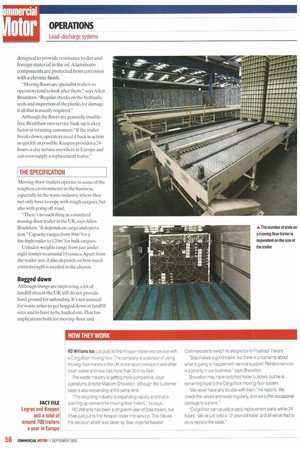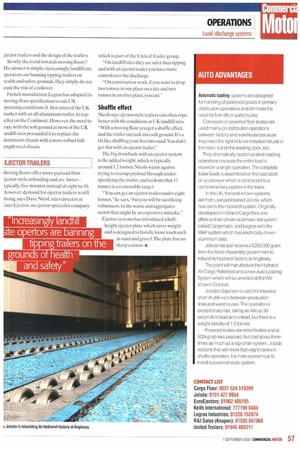HONORABLE DISCHARGE
Page 54

Page 55

Page 56

Page 57

If you've noticed an error in this article please click here to report it so we can fix it.
With turnaround speeds now a top priority, sales of automatic loading systems are on the increase. Sharon Clancy reports.
Sales of moving floors and other automatic load-discharge systems are on the increase as operators strive to minimise turnround time and increase their flexibility. The big markets are in the areas of waste operations, loose cargo transport such as aggregates and building materials and fastmoving distribution operations.
The waste sector covers a multitude of commodities. from household waste to scrap metal, broken glass and tyres. It's a specialised market, with Legras and Knapen, for example, selling around 700 trailers a year in Europe between them.
Automatic cargo loading systems are a different breed, but operators are equally prepared to invest in them in order to gain the operational benefits.
WASTE TRAILERS
Despite their weight resulting in loss of payload (a typical trailer with aluminium moving floor comes in at around 7.25 tonnes). it is the sheer versatility of moving floors that ensures their popularity with certain operators. In the waste industry it is the improved safety that appeals: there is reduced risk of rollover compared with tippers.
Moving-floor trailers can handle loose cargo and palletised goods. So an operator can, theoretically, carry loose cargo one way and palletised goods on the return. Eddie Stobart has just put into service a batch of Knapen trailers with moving floors which will be used to carry both loose and palletised cargo.
Most Knapen trailers are sold with moving floors from fellow Dutch company Cargofloor. will fit any system the customer requires," says Allan Bradshaw, managing director of Knapen UK. "However, we know the Cargofloor system and what it can cope with and it is reliable in service."
Cargofloor features chromed valves to inhibit corrosion and casehardened hydraulic cylinders for strength.
US manufacturer Keith Walking Floor invented the moving-floor concept. At this year's CV Show Keith introduced a heavy-duty moving floor, the V-floor. It is designed for heavy-impact operations and highly abrasive materials such as crushed concrete, demolition waste, machine off-cuts and sand.
UK manager Mark Allen says the floor is tough enough to cope with loose glass without a liner. On the V floor the flat-topped aluminium slats are replaced with high-tensile-steel V-shaped slats. The V-shaped slats are better at resisting abrasion and preventing material getting jammed between the planks.
Although new to the UK the system has been operating in the US for the past two years, says Allen, with a system fitted to a trailer fromAtlantic Trailers in operation in the UK for the past six months.
Enhanced strength
If your priority is speed of unloading then the Keith Running Floor H takes some beating.
• The cylinder design distributes the forces on the drive frame evenly on either side, which enhances durability and speeds up operation. The barrel of the cylinder is attached to he cross-drives which eliminates flexing of he rod during operation.The even distribuion of the hydraulic force on either side allows (eith to virtually double the amount of oil in he system from a typical 110 litres to 200 litres, vhich is why the company claims it is faster to Lnload than competitors' systems.
Allen says that on a typical 13.4-metre railer, unloading time is five minutes for the V teel floor and under five minutes with the luminium floor, compared with double that or other systems.
Infrared remote control is now virtually tandard on all moving floors. Like tail-lifts and Drry-mounted cranes, moving floors fall within he Supply of Machinery Safety Regulations, vith the onus on the manufacturer to eliminate rotential risk for safe operation.
Infrared control allows the driver to see vhat is happening during the discharge of the Dad without having Lobe so close to the rear hat he risks getting buried underneath the Dad as it is discharged.
The Cargofloor system, for example, opens he rear hatch and then the floor.
MAINTENANCE
Moving floors look complicated, but are in fact quite basic hydraulically operated pieces of kit which give reliable service with minimum attention.The reliability of the hydraulic drive on Keith floors, for example, has been proven and tweaked over 15 years in operation. Valve assemblies are easily removed for maintenance and the switching valve is designed to provide resistance to dirt and foreign material in the oil.Alumini um components are protected from corrosion with a chrome finish.
"Moving floors are specialist trailers so operators tend to look after them," says Allen Bradshaw." Regular checks on the hydraulic seals and inspection of the planks for damage is all that is usually required."
Although the floors are generally troublefree, Bradshaw says service back-up is a key factor in retaining customers:"If the trailer breaks down,operators need it back in action as quickly as possible. Knapen provides a 24hours-a-day service anywhere in Europe and can even supply a replacement trailer."
THE SPECIFICATION
Moving-floor trailers operate in some of the toughest environments in the business, especially in the waste industry, where they not only have to cope with rough cargoes, but also with going off-road.
"There's no such thing as a standard moving-floor trailer in the UK, says Allen Bradshaw. "It depends on cargo and operation." Capacity ranges from 90m3 for a 4m-high trailer to 120m3 for bulk cargoes.
Unladen weights range from just under eight tonnes to around 10 tonnes. Apart from the trailer size, it also depends on how much extra strength is needed in the chassis.
Bogged down Although things are improving, a lot of landfill sites in the UK still do not provide hard ground for unloading. It's not unusual for waste artics to get bogged down in landfill sites and to have to be hauled out. That has implications both for moving-floor and ejector trailers and the design of the trailers.
So why the trend towards moving floors? The answer is simple: increasingly, landfill site verators are banning tipping trailers on aealth and safety grounds.They simply do not want the risk of a rollover.
French manufacture Legras has adopted its noving-floor specification to suit UK verating conditions. It first entered the UK -narket with an all-aluminium trailer, its top;eller on the Continent. However, the need to eope with the soft ground at most of the UK andf ill sites persuaded it to replace the iluminium chassis with a more robust fullength steel chassis.
EJECTOR TRAILERS
vloving floors offer more payload than ejector-style unloading and are faster — ypically, five minutes instead of eight to 10. lowever, demand for ejector trailers is still 4rong, says Dave Nicol, sales director at Euro Ejector, an ejector specialist company which is part of the United Trailer group.
"On landfill sites they are safer than tipping and with an ejector trailer you have more control over the discharge.
"On construction work. if you want to drop two tonnes in one place on a site and two tonnes in another place, you can."
Shuffle effect
Nicols says ejector-style trailers can often cope better with the conditions at UK landfill sites. "With a moving floor you get a shuffle effect, and the trailer can sink into soft ground. It's a bit like shuffling your feet into sand. You don't get that with an ejector trailer."
The big drawback with an ejector system is the added weight, which is typically around 1.2 tonnes. Nicols warns against trying to recoup payload through underspecifying the trailer, and reckons that 11 tonnes is a reasonable target.
"You can get an ejector trailer under eight tonnes," he says,"but you will he sacrificing robustness. In the waste and aggregates sector that might bean expensive mistake.Ejector systems has introduced a halfheight ejector plate which saves weight and is designed to handle loose loads such as sand and gravel.The plate has no sharp corners •




































































































































































































